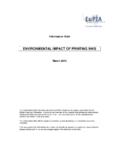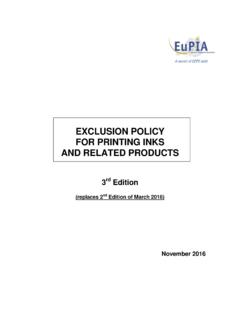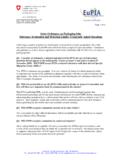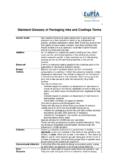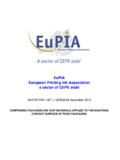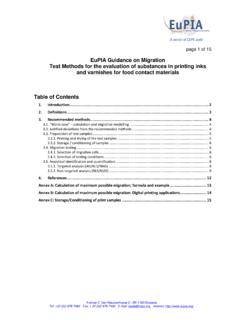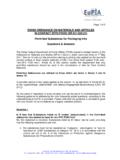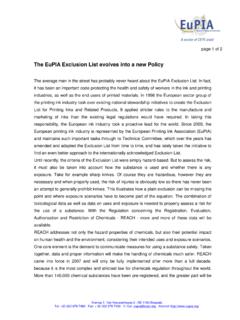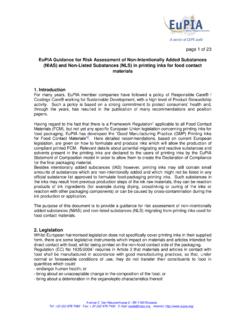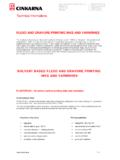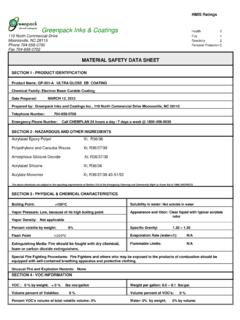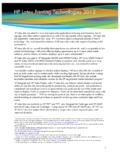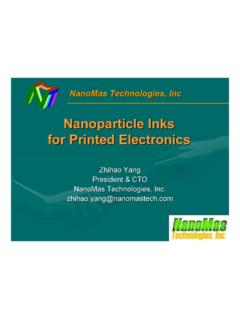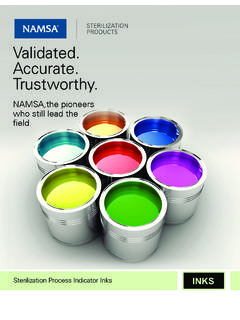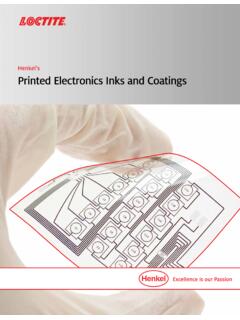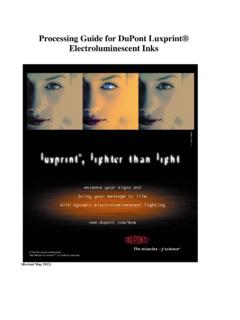Transcription of EuPIA Guideline on Printing Inks
1 EuPIA Guideline on Printing inks applied to the non-food contact surface of food packaging materials and articles November 2011. - corrigendum July 2012 - (Replaces the September 2009 version). 1. Introduction EuPIA member companies have, for many years, followed a policy of Responsible Care / Coatings Care working for Sustainable Development, with a high level of Product Stewardship activity. This is based on a strong commitment to protect consumers' health, and, through the years, has led to the publication of many recommendations. 1. Having regard to the fact that there is a Framework Regulation applicable to all food packaging, but not yet any specific Community legislation concerning Printing inks for food packaging, EuPIA have developed a Guideline for their members, based on current European legislation, which gives detailed recommendations as to how to formulate inks which will comply with this Regulation; this is in line with the EuPIA strategy in the field of packaging inks .
2 It also takes into account the work done in cooperation with the Council of Europe Committee of Experts on Food Contact Materials. 2. Legislation Whilst European harmonised legislation does not specifically cover Printing inks in their supplied form, there are some legislative instruments which impact on materials and articles intended for direct contact with food, whilst being printed on the non-food-contact side. 1. Regulation (EC) No 1935/2004 requires in Article 3 that materials and articles in contact with food shall be manufactured in accordance with good manufacturing practices, so that under normal or foreseeable conditions of use, they do not transfer their constituents to food in quantities which could: - endanger human health; or - bring about an unacceptable change in the composition of the food; or - bring about a deterioration in the organoleptic characteristics thereof. inks , once printed and dried/cured, on the non-food-contact side of a packaging material in contact with food become a component of this packaging and this packaging has to comply with the requirements of Article 3.
3 EuPIA recommends ensuring traceability during ink manufacturing analogous to the requirements as set out in Article 17: - the traceability of printed materials and articles at all stages in order to facilitate control, the recall of defective products, consumer information and the attribution of responsibility . 1. REGULATION (EC) No 1935/2004 OF THE EUROPEAN PARLIAMENT AND OF THE COUNCIL of 27 October 2004 on materials and articles intended to come into contact with food and repealing Directives 80/590/EEC and 89/109/EEC, OJEU L338 of 13. 11. 2004. Avenue E. Van Nieuwenhuyse 6 - BE-1160 Brussels Tel: +32 (0)2 676 7480 - Fax: + 32 (0)2 676 7490 - E-mail: - Internet: EuPIA Guideline on Printing inks applied to the non-food contact surface of food packaging materials and articles November 2011. 2. Directive 2007/42/EC relating to materials and articles made of regenerated cellulose film states that the printed surface of regenerated cellulose film must not come into contact with food, and therefore is relevant to Printing inks for food packaging.
4 The main specific measure pursuant to the Framework Regulation is Regulation (EU) No 10/2011 on plastic materials and articles intended to come into contact with food. It lays down an overall migration limit (OML) of 60 mg/kg food or 10 mg/dm of surface area. In addition specific migration limits (SML) or maximum contents in the material or article (QM) are set for individual substances. The Regulation contains a positive list (Union list) of substances authorised to be used in the manufacture of plastics. Packaging inks in their supply form are not in the scope of the Regulation, as they may be subject to other EU or national rules. Therefore, inks may be composed of other substances than those authorised at EU level for plastics. However, printed plastic materials and articles are within the scope of the Regulation. If there are ink components which are listed in the Union list, then the relevant restrictions such as specific migration limits (SML) or maximum content (QM) must be met and where there is the presence of dual use additives in the inks the legal provisions must also be followed.
5 St Regulation (EC) No 2023/2006, applicable from 1 August 2008, sets out rules on Good Manufacturing Practice for the production of food contact articles. It has an Annex referring to Printing inks applied to the non-food-contact surface of food packaging as well as to the storage of printed articles. In summary it can be concluded that the ink manufacturer does not have an independent responsibility for the formulation and application of the inks , but this remains ultimately with the downstream partners. To allow shared and final responsibilities to be met there needs to be cooperation between ink manufacturer and the rest of the supply chain. The cooperation between ink manufacturer and converter is best managed by requirement specifications, by detailed information about the substrate, type of food packed, Printing and converting process parameters, storage and treatment conditions. When provided with this information the ink manufacturer is enabled to formulate inks that comply with the Regulation, if they are correctly used.
6 Other legislative references are set out in Appendix 3. 3. Field of Application This Guideline applies to Printing inks , coatings and varnishes (hereafter called packaging inks '), applied by an appropriate process to the non food contact surface of any material or article intended to come into contact with foodstuffs. Printing inks in direct contact with foodstuffs are excluded from the field of application of the present Guideline . 4. Definitions Packaging inks are preparations (mixtures) manufactured from combinations of colorants (pigments, dyes), binders, solvents, and additives. They are solvent-based, water-borne, oleo- resinous or energy-curing (UV or electron beam) systems. They are applied by a Printing and/or a coating process, such as flexography, gravure, letterpress, offset, screen, non-impact Printing or roller coating. Packaging inks layers, in their finished state, are thin dried or cured films of packaging ink on the non-food contact surface of substrates.
7 Substrate is any material or article intended to come into contact with food, these include glass, metal, paper, board, plastic, textiles and laminates of these materials. 5. Requirements Printed packaging materials and articles intended to come into contact with foodstuffs shall not, in their finished state - under normal and foreseeable conditions of use - transfer their constituents to EuPIA Guideline on Printing inks applied to the non-food contact surface of food packaging materials and articles November 2011. 3. foodstuffs in quantities which could endanger human health, or bring about an unacceptable change in the composition of the foodstuffs, or a deterioration in the organoleptic characteristics thereof, in accordance with Article 3 of Regulation (EC) No 1935/2004. In order to enable the printed packaging in its finished state to achieve the legal requirements the following specifications shall be met. Specifications regarding packaging inks 2. The raw materials shall be selected in accordance with the Appendix 1 Selection scheme for packaging ink raw materials.
8 They shall not belong to the following categories (exclusion criteria): (a) classified as carcinogenic , mutagenic or toxic for reproduction categories 1. and 2, according to the provisions of Directive 67/548/EEC on dangerous substances (categories 1A and 1B according to CLP, Regulation (EC) No 1272/2008). Note: Category 3 substances (CLP Category 2) will only be used after a migration study has confirmed that migration levels are either within published SML or TDI values, or are below an intake (threshold of toxicological concern) of 3. g/person/day . Category 3 reproductive toxicants (R62, R63; H361f, H361d) without a published limit may be used if the migration levels are confirmed to be not detectable (with a detection limit of mg/kg food);. (b) classified as toxic and very toxic;. 4. (c) colorants based on and compounds of antimony , arsenic, cadmium, chromium (VI), lead, mercury, selenium;. (d) all substances identified in the REACH Regulation (EC) No 1907/2006, Title VIII.
9 And Annex XVII (restrictions on the manufacturing, placing on the market and use of certain dangerous substances, mixtures and articles) and its amendments, if their use in a packaging ink would lead to an infringement of Article 3 of the Framework Regulation. The packaging inks shall be formulated and manufactured in accordance with the EuPIA Good Manufacturing Practices for the Production of Packaging inks formulated for use on the non-food contact surfaces of food packaging and articles intended to come into contact with food ( GMP ), available at Specifications regarding the packaging material and article The packaging inks shall be used and applied in accordance with recognised converters' good manufacturing practices. The printed or overprint varnished surfaces of food packaging shall not come into direct contact with food. There shall be no visible transfer ( physical) from the printed or varnished non- food contact surface to the food contact surface. Global and specific migrations from the packaging in its finished state or article shall not exceed the relevant limits.
10 6. Responsibility The Printing ink manufacturers' responsibility is to supply products that are fit for the intended purpose as defined between members of the packaging chain. They are not liable for any aspects of the production of food packaging once the packaging inks have left the 2. Raw materials may contain starting substances and/or components which are CMR or T, T+, but at levels which do not trigger a classification of the raw material itself as CMR Cat. 1 or 2 (CLP 1A or 1B) or T, T+. Any migration of these into foodstuffs must comply with any relevant limit. 3. ILSI, Threshold of Toxicological Concern (TTC), Monograph, 2005, 4. With the exception of non-bio-available pigments in which antimony is a constituent of the crystal lattice and of organic derivatives not classified nor labelled as T or T+. EuPIA Guideline on Printing inks applied to the non-food contact surface of food packaging materials and articles November 2011. 4. manufacturing site. The manufacturer of the packaging and the filler are responsible for the properties of the food packaging and its compliance with legal requirements.
